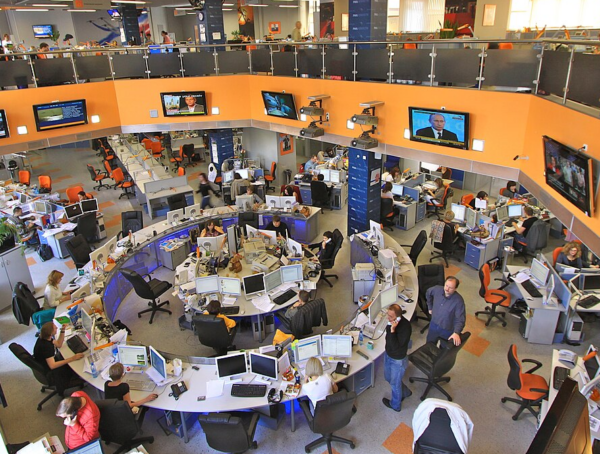For more than 200 years, newspapers delivered information to readers the exact same way: every day, on newsprint, in black and white (and then color) and on the doorstep.
In the last 20 years, news organizations and newsrooms have needed to evolve faster, and in more diverse directions, than anyone ever dreamed. Mobile devices have become the go-to device for news consumption—and news creation, for that matter—in a 24-7, never-ending news cycle.
It’s the challenge of the 21st century news organization to balance the core foundation of journalism and news gathering with ever-changing technology, paywalls, virtual reality, mobile phones and tablets … and so much more.
 Joey Marburger is on the front lines of this challenge at The Washington Post, one of the most historic and now cutting-edge digital journalism organizations in the United States.
Joey Marburger is on the front lines of this challenge at The Washington Post, one of the most historic and now cutting-edge digital journalism organizations in the United States.
As director of product, Marburger is always trying to stay ahead of the curve in terms of technology while not only maintaining but strengthening the integrity of journalism delivered by the Post. His role evolved from the chasm and ultimately confluence of both.
“Product is the intersection of news or journalism and technology and there’s some business component,” Marburger says. “So, if you have a three-circle Venn diagram of journalism, business and technology, product is in the center of that, where they intersect and overlap.”
What really elevates something to a product, he says, is that business component—meaning clear strategy or revenue or new market opportunities connected to it.
“Our core product is journalism and the news we’re producing, but to find the business component of that you have to have the physical product through which you consume the news. That’s what my job is. It’s everything but print,” Marburger says. “It’s funny. What product became at the Post was the perfect happenstance for my career because I was already doing both. I was heavily passionate about news and I knew how to code and I was just always bringing the two together, but not always realizing what I was doing. I just knew you could try to do both.”
Now he’s tasked with not only the development of new ways to deliver the news, but helping those who gather it understand the technology that will support and showcase their craft. Again, he finds himself bringing his two passions together to help others face this brave new world and weave together art of two very different natures.
“The only way you can do that is having trusted people on all sides that know how to speak each other’s language,” Marburger says. “So, I’ve had great support from the newsroom in bringing technology into the newsroom more—to make it more tightly related and not think of it as two separate divisions. Then we’ve hired smartly and have great people on the technology side who could have worked anywhere in the tech sector, but love news. So, when you have people that are willing to work together on both sides it evolves almost naturally. But you have people that hold out and don’t understand, and that’s where you need to be able to communicate.”
Marburger acknowledges that the effort to bring everyone along is “still ongoing.”
His team is responsible for all the ways that readers interact with the Post, Marburger says, “so product is like the new printing press in some ways.”
Marburger says he’s trying to educate the newsroom about telling the story in different ways on different platforms. For example, a 3,000-word story for the Post website could be adapted into an audio-only interactive story for Alexa, the voice-activated personal assistant from Amazon, which is owned by Washington Post owner Jeff Bezos.
That is something “we’re working on right now—innovative storytelling on one platform, but with the core of the story pretty straight-forward on our website,” Marburger says. “That’s what product brings. We’re always looking at new platforms to expand on where it’s not just a copy-and-paste type thing. So, we can really say not only are we going to tell our stories on these new platforms, but we’re going to tell them how the platform wants us to tell them.
“Reading a 3,000-word story straight up on Alexa is not going to be great, so that’s where product comes in to help them with the experience of the story. And you do that enough times on enough stories and innovations just kind of happen. But you have to be willing to do that especially at a time when everyone’s busy, everyone’s being asked to do more. News is crazy right now on all fronts.”
That “crazy” element extends to the new platforms and technologies being used to deliver content. One cutting-edge technology some organizations are exploring is virtual reality.
“I was a person who didn’t think it was a good idea,” Marburger says. “It’s cool but it’s not there yet. But we should be paying attention to it and try a story here or there. I was very cautious, so we didn’t go very far with that. We could have gone all in and hired a whole team to develop that, but then we probably would have been eliminating now because there’s just not the support for it yet. Not enough people would benefit from that type of immersive experience.”
Instead, Marburger says he was more comfortable trying augmented reality. So in May 2017, The Post launched an Augmented Reality series that took readers inside some of the world’s billion-dollar buildings. The first site showcased was the Elbphilharmonie concert hall in Hamburg, Germany.
Marburger explained readers could use their smart phones to re-create the experience of being inside this state-of-the-art facility. “Not that many people ended up experiencing it,” Marburger says. “But of those that did, 80 percent followed it all the way through to completion.”
Whenever a news organization is trying something new, like AR, that requires a lot of development time, Marburger said, it’s always best to get a sponsor. Audi filled that role for the billion-dollar building series.
“I think AR is still a couple more years away from being widely accessed, but I think it’s coming,” he says. “In time, it’s going to become a regular part of our technology.”
Obviously, not every organization has the resources or the networking to finance new ventures. So, Marburger offers this advice for small newsrooms that want to explore expanding product.
“There are exercises they can do to lead them through the process, to help them think about what will serve their consumers best and what will befit them most,” Marburger says. He suggests staffs try either IDEO design thinking exercises or Google Ventures’ brainstorming system they can follow to determine what will benefit their readers.
As for what’s next in the realm of product among news organizations, Marburger expects more AR. But even sooner, he expects us all to see more competition.
“I think immediately what’s next is expansion of news on various platforms,” Marburger says. “People are taking news more seriously and people are willing to pay for it, so new players will emerge. That means competition and it will be interesting to see how that affects things.”
 Deborah Caro Goldman has worked as a writer-producer at WTTG in Washington, D.C., and as a news producer at WSOC-TV in Charlotte, North Carolina, and at WTEN in Albany, New York. She was an anchor, reporter and producer at WAGM in Presque Isle, Maine. A 1990 graduate of Syracuse University, she has degrees in policy studies and broadcast journalism and graduated summa cum laude and Phi Beta Kappa. She has a master’s degree from the Medill School of Journalism, finishing her program in Washington, D.C., as a correspondent for WDAY in Fargo, North Dakota. Contact her at debgoldman@msn.com.
Deborah Caro Goldman has worked as a writer-producer at WTTG in Washington, D.C., and as a news producer at WSOC-TV in Charlotte, North Carolina, and at WTEN in Albany, New York. She was an anchor, reporter and producer at WAGM in Presque Isle, Maine. A 1990 graduate of Syracuse University, she has degrees in policy studies and broadcast journalism and graduated summa cum laude and Phi Beta Kappa. She has a master’s degree from the Medill School of Journalism, finishing her program in Washington, D.C., as a correspondent for WDAY in Fargo, North Dakota. Contact her at debgoldman@msn.com.








